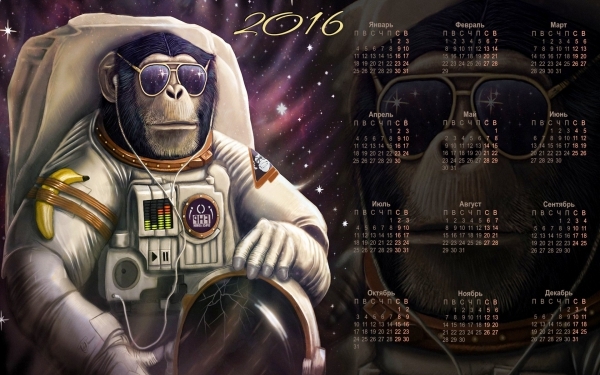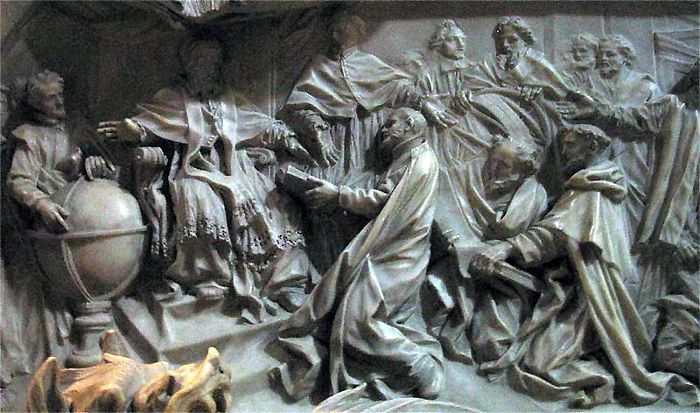New Year and calendar. A bit of space on a holiday

According to European tradition, the New Year has been celebrated for two millennia on the night of the first of January. As we all are accustomed to, this day falls in our hemisphere during the winter season. In this regard, this holiday is symbolically personified in our character of Santa Claus. Fans of a warmer pastime on holidays leave for the southern hemisphere, where today is the height of summer.
However, nature does not tolerate constancy. The sun is gradually changing its position in the celestial sphere at the same times of the year, making it difficult for a person to create a reliable calendar in the long run. Moving in time, we will visually follow the influence of cosmic forces on the earth’s calendar, and how the resourceful mind of a person had to “tame” time, despite the inexorable forces of nature.
The change of seasons on Earth is directly related to the inclination of the equator of our planet to the plane of its orbit, which is now equal to 23.5 °. In early January, when the Earth passes the point of its orbit closest to the Sun (perihelion equal to 147 million km), the southern hemisphere of the planet receives more solar energy than the northern one. The situation changes to the opposite at the beginning of July, when our planet passes already the most distant part of the orbit (apogelium or aphelion, equal to 152 million km). Due to the constant tidal influence of the Sun and the Moon, the axis of the Earth's daily rotation describes a circle in space with a period of 26,000 years, practically without changing the angle of its inclination to the plane of the Earth's orbit.
The simulation in the Stellarium program clearly demonstrates the path of the north pole of the celestial sphere among the constellations. The diameter of the circle described by the precession is approximately 47 ° (about 100 visible diameters of the moon), centered halfway between Vega and the North Star
Oscillations of the axis of rotation of the Earth in space

For tens of thousands of years, the stars themselves also change their position in the celestial sphere. This video shows a chaotic change in the position of stars in constellations 100,000 years before and after our time. Only the constellations “composed” by distant bright giants remain relatively motionless (the constellation of Orion in the lower right corner)
Calendar issue
To count the time, ancient people used the solar and lunar calendars. The days of the vernal equinox or winter solstice marked the onset of the new year. This practice was very important for ancient farmers, as evidenced by the large number of megalithic structures on the Eurasian continent, the main purpose of which is to determine the beginning of land work. Christian Easter and Navruz of the peoples of Central Asia are closely connected with the ancient cults of the vernal equinox (March 19-21).
La Roche-o-Feu, a megalithic structure 5,000 years old, located near my place of work, Brittany, France. Every year on December 21, crowds of onlookers watch the Sun illuminate the corridor of this structure, which marks the day of the winter solstice (the shortest day of the year). Such structures are spread over a wide area of Eurasia, from eastern Europe to Scotland. The

time between the equinoxes, in turn, was divided into shorter periods of alternation of the same lunar phases (about 13). As mentioned above, the special status of the vernal equinox (the days of the revival of nature after winter) marked the beginning of the countdown of the new year among many peoples.
So in March the year began among the ancient Slavs. From the same month (from the 15th day) the year began according to the Roman calendar. However, the development of civilization and increased demands on the accuracy of calendars led to the appearance of calendars of a type familiar to modern man.
In 45 BC in ancient Rome, a new calendar was introduced, based on the old Etruscan-Roman and Egyptian calendar, the so-called Julian, by the name of Gaius Julius Caesar.
The old Roman calendar consisted of 12 months, the names of which are still largely preserved: As already mentioned, the year began with Marta (in honor of the god Mars), followed by April ("opening" the beginning of spring), May (in honor of the Mayan galaxy , goddess of fertility), June (in honor of Juno), Quintilis (“fifth” later in July, in honor of Julius Caesar), Sextilis (“sixth”, later August in honor of Octavian Augustus), September (“seventh”), October (“ eighth ”), November (“ ninth ”), December (“ tenth ”), January (in honor of the god Janus) and Februarius (“ month of purification ”). Once every few years, Mercedonius, 13 months, was introduced.
The reform of Julius Caesar introduced such norms as the unequal number of days in a month, and the addition of one day in February every 4 years is a “leap year”. The New Year began to reckon with the usual January 1, as it was on this day in the Roman Republic that consuls were elected for a period of one year.
God Janus in a mythological representation had two faces, one old, turned into the past, and the second young, turned into the future. Thus, Janus, in the later republic and then empire, symbolized the transition from the old year to the new one.

However, the Julian calendar, already consisting of 365 days a year, gave an error of 1 day every 128 years. Already in the 16th century, Pope Gregory carried out a calendar reform due to a significant discrepancy in the lunar calendar, which determines the day of Easter and the day of the vernal equinox.
Pope Gregory 13th introduces a new calendar. Bas-relief, St. Peter's Basilica, Rome

As a result of the reform, October 4 immediately followed the 15th day of the same month of 1582 (in Italy), leap years (366 days) were considered years divisible by 4, but not divisible by 100, and all years divisible by 400. One day error in relation to spring day The equinox accumulated over 10,000 years. Unlike the Catholic Church, the Eastern Orthodox Church then refused to switch to the Gregorian calendar. Initially, Christian Christmas was associated with the days of the winter solstice (December 20th), which the Catholic world continues to celebrate on December 25, following the Gregorian calendar. Due to errors accumulated by the Julian calendar in relation to the Gregorian, Orthodox Christmas is celebrated 13 days later - January 7. The transition to the Gregorian calendar was made in Russia after the 1917 revolution.
Decree of January 26, 1918, on the transition of Soviet Russia to the calendar of the "new", Gregorian style. The Julian calendar in Soviet (and later Russian) historiography will be marked as a calendar of the "old" style

Due to the precession of the Earth, the position of the sun in the sky during the vernal equinox and winter solstice gradually changes over the course of millennia. In the long term (after 11,000 years), this will lead to the fact that summer in the northern hemisphere will fall on the period when the Earth passes the perihelion of its orbit, and winter, accordingly, the apogel. The question arises, does this mean that the summer in Europe in that era will be in December and January, and the winter in June? Not quite as noted above, the Gregorian calendar was designed so that Christian calendar holidays would correspond as closely as possible to the days of the vernal equinox and winter solstice. That is, the months and days are “adjusted” to the height of the sun above the horizon at a certain time of the year, and not to the position of the sun on a starry background on the same days.
In our time, on January 1, the Sun is in the constellation Sagittarius, but after 11,000 years on the same day it will be in the constellation Cancer. Nowadays, the constellation Cancer Sun "flies" in the summer. The usual winter constellations of the northern hemisphere, in that distant era, will be observed already in the summer sky, and vice versa.
It is quite obvious that in 10,000 years another, more accurate calendar than the Gregorian calendar will be adopted, but modern calendars can serve us for thousands of years. Our descendants will reckon the New Year from January 1, sitting at the festive table warming them in this cold season of the northern hemisphere!
Happy New Year 2016 to all! Fewer crises, more happiness and enlightenment to all of you!
